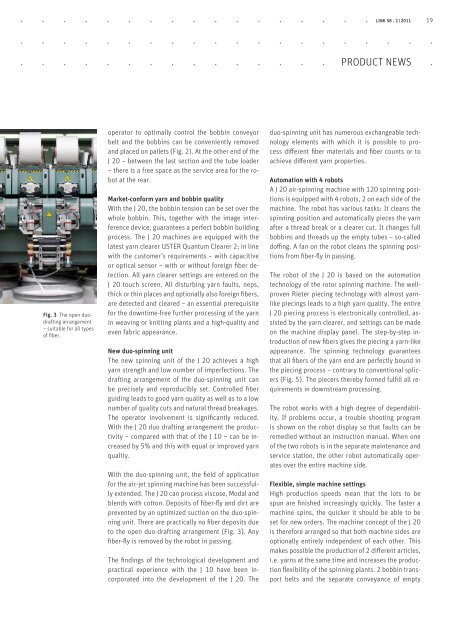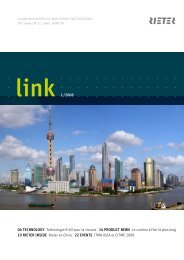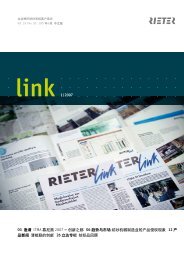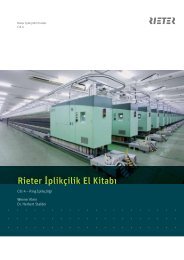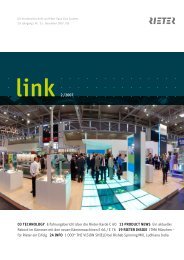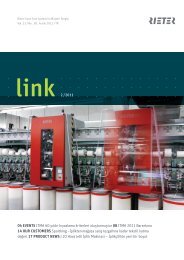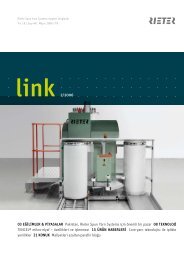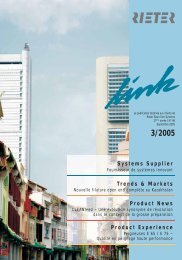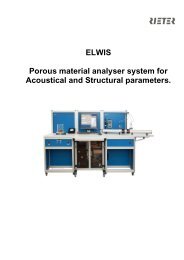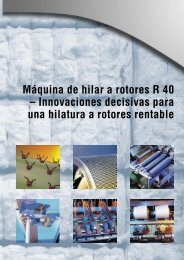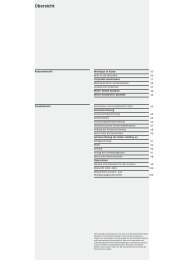Download LINK - Rieter
Download LINK - Rieter
Download LINK - Rieter
You also want an ePaper? Increase the reach of your titles
YUMPU automatically turns print PDFs into web optimized ePapers that Google loves.
Fig. 3 The open duodrafting<br />
arrangement<br />
– suitable for all types<br />
of fiber.<br />
operator to optimally control the bobbin conveyor<br />
belt and the bobbins can be conveniently removed<br />
and placed on pallets (Fig. 2). At the other end of the<br />
J 20 – between the last section and the tube loader<br />
– there is a free space as the service area for the robot<br />
at the rear.<br />
Market-conform yarn and bobbin quality<br />
With the J 20, the bobbin tension can be set over the<br />
whole bobbin. This, together with the image interference<br />
device, guarantees a perfect bobbin building<br />
process. The J 20 machines are equipped with the<br />
latest yarn clearer USTER Quantum Clearer 2; in line<br />
with the customer’s requirements – with capacitive<br />
or optical sensor – with or without foreign fiber detection.<br />
All yarn clearer settings are entered on the<br />
J 20 touch screen. All disturbing yarn faults, neps,<br />
thick or thin places and optionally also foreign fibers,<br />
are detected and cleared – an essential prerequisite<br />
for the downtime-free further processing of the yarn<br />
in weaving or knitting plants and a high-quality and<br />
even fabric appearance.<br />
New duo-spinning unit<br />
The new spinning unit of the J 20 achieves a high<br />
yarn strength and low number of imperfections. The<br />
drafting arrangement of the duo-spinning unit can<br />
be precisely and reproducibly set. Controlled fi ber<br />
guiding leads to good yarn quality as well as to a low<br />
number of quality cuts and natural thread breakages.<br />
The operator involvement is significantly reduced.<br />
With the J 20 duo drafting arrangement the productivity<br />
– compared with that of the J 10 – can be increased<br />
by 5% and this with equal or improved yarn<br />
quality.<br />
With the duo-spinning unit, the field of application<br />
for the air-jet spinning machine has been successfully<br />
extended. The J 20 can process viscose, Modal and<br />
blends with cotton. Deposits of fiber-fly and dirt are<br />
prevented by an optimized suction on the duo-spinning<br />
unit. There are practically no fiber deposits due<br />
to the open duo-drafting arrangement (Fig. 3). Any<br />
fiber-fly is removed by the robot in passing.<br />
The findings of the technological development and<br />
practical experience with the J 10 have been incorporated<br />
into the development of the J 20. The<br />
<strong>LINK</strong> 58 . 2 /2011<br />
PRODUCT NEWS<br />
duo-spinning unit has numerous exchangeable technology<br />
elements with which it is possible to process<br />
different fiber materials and fiber counts or to<br />
achieve different yarn properties.<br />
Automation with 4 robots<br />
A J 20 air-spinning machine with 120 spinning positions<br />
is equipped with 4 robots, 2 on each side of the<br />
machine. The robot has various tasks: It cleans the<br />
spinning position and automatically pieces the yarn<br />
after a thread break or a clearer cut. It changes full<br />
bobbins and threads up the empty tubes – so-called<br />
doffing. A fan on the robot cleans the spinning positions<br />
from fiber-fly in passing.<br />
The robot of the J 20 is based on the automation<br />
technology of the rotor spinning machine. The wellproven<br />
<strong>Rieter</strong> piecing technology with almost yarnlike<br />
piecings leads to a high yarn quality. The entire<br />
J 20 piecing process is electronically controlled, assisted<br />
by the yarn clearer, and settings can be made<br />
on the machine display panel. The step-by-step introduction<br />
of new fibers gives the piecing a yarn-like<br />
appearance. The spinning technology guarantees<br />
that all fibers of the yarn end are perfectly bound in<br />
the piecing process – contrary to conventional splicers<br />
(Fig. 5). The piecers thereby formed fulfill all requirements<br />
in downstream processing.<br />
The robot works with a high degree of dependability.<br />
If problems occur, a trouble shooting program<br />
is shown on the robot display so that faults can be<br />
remedied without an instruction manual. When one<br />
of the two robots is in the separate maintenance and<br />
service station, the other robot automatically operates<br />
over the entire machine side.<br />
Flexible, simple machine settings<br />
High production speeds mean that the lots to be<br />
spun are finished increasingly quickly. The faster a<br />
machine spins, the quicker it should be able to be<br />
set for new orders. The machine concept of the J 20<br />
is therefore arranged so that both machine sides are<br />
optionally entirely independent of each other. This<br />
makes possible the production of 2 different articles,<br />
i.e. yarns at the same time and increases the production<br />
flexibility of the spinning plants. 2 bobbin transport<br />
belts and the separate conveyance of empty<br />
19


